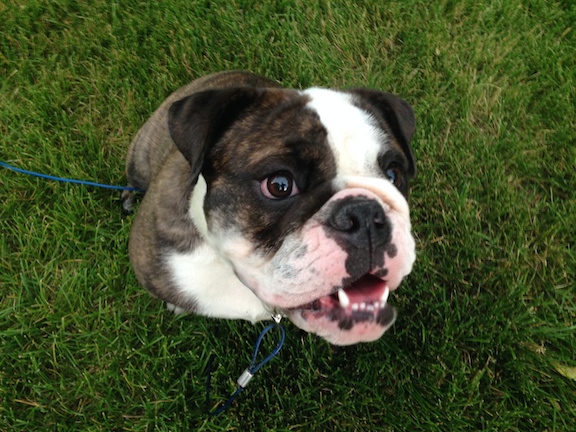Teaching Blanche the English Bulldog to Stay Calm and Mind Her Owners
By: David Codr
Published Date: June 24, 2014

As soon as I met her in person, I understood why her owners called me for help. Blanche was so wound up it was clearly difficult for her to pay attention to commands or corrections. In fact, when corrected she just ignored the person or moved on to getting into something else that was off limits; my bag, kids toys, chewing on any wood furniture near her mouth, etc.
I started out by showing them my technique to stop Blanche from jumping up on people. Blanche was determined as many Bulldogs are so it took a few repeated corrections before she “got-it.” After that point, she jumped up, but avoided making contact with me. This is the usual first step in the process of a dog learning to not jump up on people.
Next we sat down to discuss what her owners wanted to get out of the session. But as soon as we started that conversation, Blanche sniff-attacked my bag, no doubt trying to find the bag of high value meat treats I brought to use for her session.
When I disagreed with her, she attempted to ignore me, then switched to pure Bulldog mode – trying to go through and around me to get to the bag of goodies.
I stayed with it and blocked her each time she tried to sneak or bully her way past (pun intended). Usually I stick with this technique until the dog realizes its not going to win and gives up. But after working with Engligh Bulldogs in the past, I knew that technique may take up more of the session than I wanted.
Instead I pulled out a short four foot leash, attached it to Blanche’s collar and then stepped on it about 12 inches from where it attached to her collar. She pulled and huffed and puffed for a minute before sitting, then laying down.
As soon as she was laying down in a calm manner, I slowly and gently stepped off the leash. Because I did it slowly and without fanfare, she didnt realize she was no longer restrained. She laid down there for the next ten minutes as I discussed the situation with her owners.
One of her owners told me that it was very rare for her to stop and lay down once she started to get all riled up. I suggested that they start to incorporate this technique any time the dog started to get too excited. The key is to do so BEFORE the dog gets too worked up. Its much easier to stop or calm a dog down when its not at the height of its energy spike.
I also advised them to look for opportunities to pause any time the dog starts to get over excited; when pulling out a leash to go for a walk, when putting food into her bowl, when the kids start running around. By stopping and making the dog stop and sit down until it is calm before continuing, we can help condition the dog to stay or move to a calmer disposition.
By the end of the session Blanche was bushed. She had sprawled out on the floor spent, much to the delight of her owners. As a English Bulldog, she is bound to try to control the situation by ignoring corrections and orders so it will be important for her owners to stay the course and not give up. Once the dog realizes that the humans mean what they say and won’t quit until the dog gives in, dogs start to respond to corrections and commands faster until its immediate.
Categorized in: Dog Behavior, Dog Psychology, Dog Training Omaha, Omaha dog training

